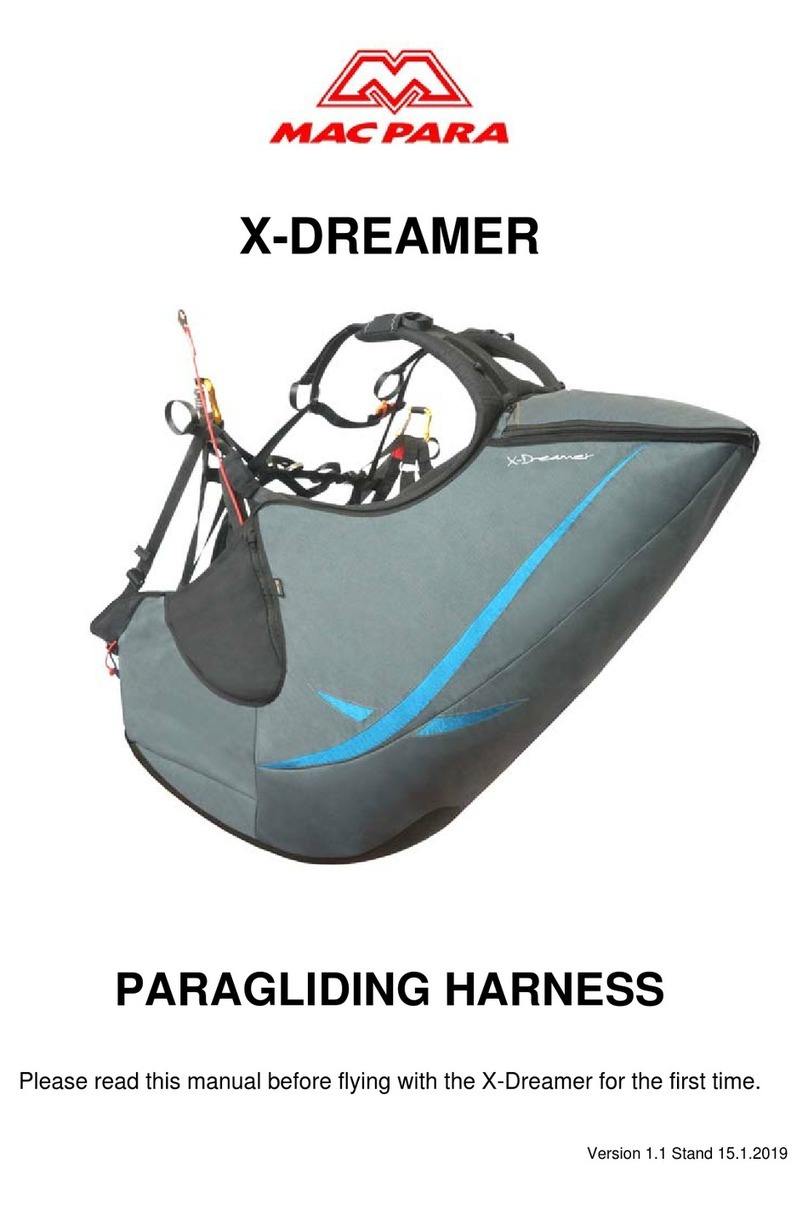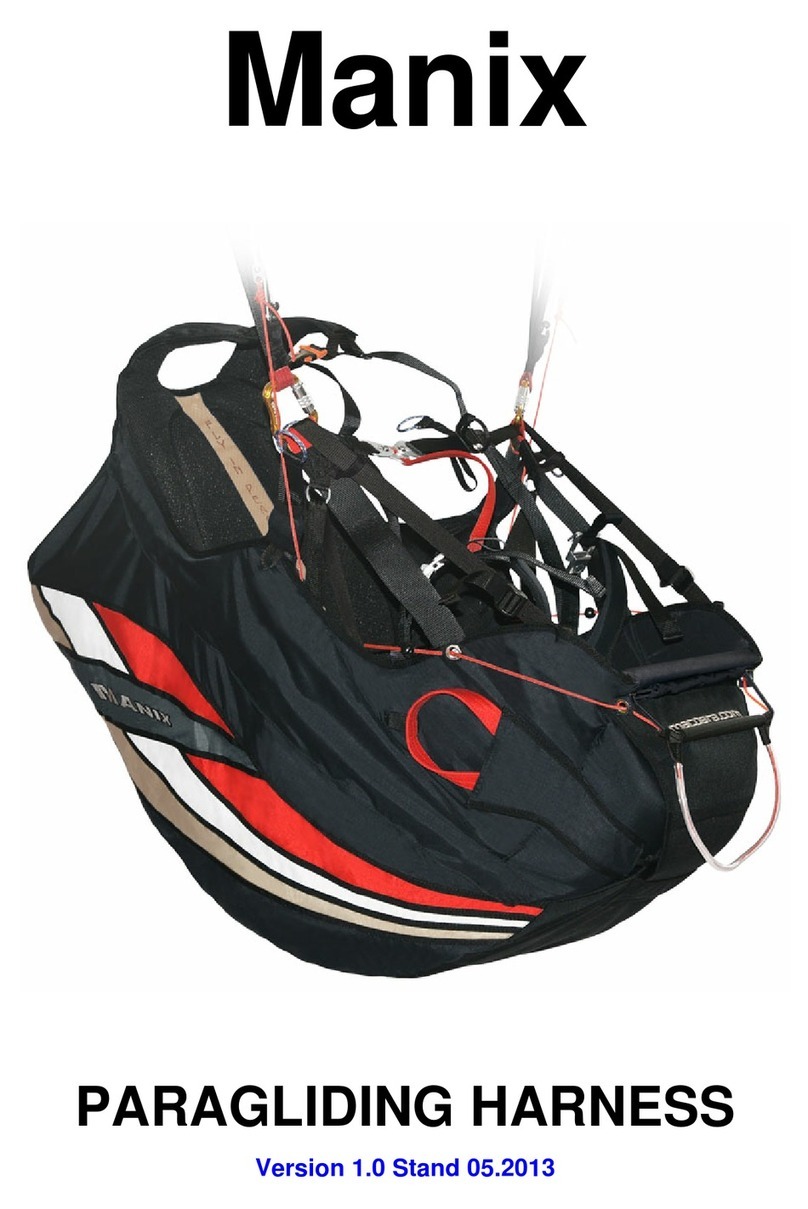MAC PARA RIDER User manual

RIDER
PARAGLIDING HARNESSPARAGLIDING HARNESS
Contents
Introduction ......................................................................................................... 3
Technicaldescription .......................................................................................... 3
Adjusting yourRider ........................................................................................... 4
........................... 6
Speedsystém ................................................................................................... 10
Towing ................................................................................................................ 10
Tandemflying ..................................................................................................... 10
............................................................................ 10
..................................................................................... 10
Thealternativemethodsofemergencyparachuteconnection
Harnesscheckbeforetakeoff
Maintenanceandrepairs

3
Introduction
Technicaldescription
AdjustingyourRider
WecongratulateyouonyourpurchaseofanewRiderharness. Youhavechosenastate
of the art product which is one of most comfortable paragliding harnesses available on
themarkettoday.
We thank you for placing your trust in us, and hope that comfortably seated you will get
maximumenjoymentduringmanyniceflights.
Please carefully read this user manual and use it as a guide to adjusting the harness
properlyforyoursizeandshape;and toobtainingthemostcomfortable flightposition.In
addition to instructions you will find a few important suggestions and tips on how to care
for,cleananduseyournewharness.
The Rider harness is built to comply with the high standards and demands for
paraglidingharnesses.
The manufacturer can not be held responsible for any accidents or injuries caused by
improperusageorfailuretocomplywiththisusermanual.
We wish you maximum enjoyment from your discovery of this fantastic aerial sport and
ofcoursehappylandings.
The Rider harness was developed to satisfy the demand for a modern paragliding har-
ness, and incorporates feed-back from pilots. MAC's long experience with design and
development of harnesses combined with use of the best selected materials warranty a
combinationoflongevity,comfortduringuseandperfectflyingcharacteristics.
The Rider harness is suitable for all pilots, from beginners to the more experienced pilot
who prefers a slightly inclined sitting position. The seat material provides pleasant leg
support and comfort. The harness is equipped with an 12. cm. foam back-protector with
a plastic reinforcing plate to protect against any penetrating impact. The foam protector
taperstoward thefrontoftheseattoreducethicknessbetweenseat andrescuesystem.
The harness can additionally be equipped with lateral protection with plastic plates
providingincreasedprotectioninthehiparea.
TheharnessisproducedfromCORDURA,afirst-rateabrasionresistantmaterial.
The Rider harness is supplied inclusive of speed bar system and brummel-hooks, as
usuallydeliveredonMACparagliders
TheRider harnessoffersyouseveraladjustmentchoices,makingitpossibleforthe pilot
tofindhisidealpositionaccordingtohissizeandshape.Theharnessisadjustableusing
shoulder, back, chest and legs straps. The harness is correctly adjusted when you feel
comfortablewithoutanypressureonshouldersorback
4
Particularsettings
Adjustingoflateralstraps
Thebasicsettingoftheanglebetweenyourbackandtheverticalaxis.
Please devote sufficient time to setting the harness correctly. Preferably hang it on a
simulatororsimilar,andcheckit,spendinglongenoughtosimulatelongperiodsofflight.
This gives you the opportunity, to easily try a number of different settings at one time
beforeundertakingyourfirstflight.
Adjustments can be made to the lateral straps leading trough the flat buckles to your
back.
When correctly adjusted you feel only light pressure on both back and shoulder. If the
lateral straps are too loose you will feel pressure on your shoulders from the shoulder
straps. By pulling on them you change the position. If you feel pressure on your back,
releasethelateralstrapsbypullingtheloopontheflatbuckles.
Adjusting of lateral straps Adjusting of bottom lateral straps
Adjusting of ABS straps Adjusting of chest strap

5
Adjustingofshoulderstraps
AdjustingofcheststrapandABSstraps
Adjustingoflegstraps
Adjustments can be made to the shoulder straps leading trough the flat buckles to your
shoulders.
When correctly adjusted you feel only light pressure on both back and shoulder. If
shoulder straps are too loose you will feel pressure on your back from the lateral straps.
By pulling on them you change the position. If you feel pressure on your shoulders
releasetheshoulderstrapsbypullingtheloopontheflatbuckles.
Shoulderstrapsdon'tslipdownthankstoanauxiliaryadjustablestrapwithaplasticclip.
The chest strap is secured with automatic Cobra buckle. The click must be audible ! By
adjustment of the chest strap the pilot determines the sensitivity of the harness.
Adjustment of the distance between the main carabineers is made by pulling loops on
chest strap. The harness is most sensitive to weight-shift when the chest strap is
released. The shorter the distance between the main carabineers the less sensitive the
harness becomes to weight shift and the effect of the special ABS-system is increased.
By pulling the loop on chest buckle the chest strap can be released. The special ABS-
narrower straps are leading from front of seat plate to the chest strap. By adjustment of
ABS straps the pilot determines sensitivity of the harness specially by use of speed
system.WhentheyarereleasedtheharnesswillbenotstabilizedbyABSsystem.
The leg straps are secured with automatic Cobra buckles. The click must be audible!
Correctly adjusted, the leg straps control the freedom of movement of the legs, before
and during take off. If the leg straps are too tight your upright position in the harness is
limited and not comfortable. If they are too slack you can have trouble sitting in the
harnessaftertakeoff.
Never forget to close buckles on leg straps !
Adjusting of leg straps Adjusting of shoulder straps
Adjustingofbottomlateralstraps-angleofseat
Possibilitiesofemergencyparachuteconnections
The Rider harness is equipped with lateral 25mm straps leading from the mainstraps to
the bottom rear of the seat plate. Using these straps you can change angle of the seat
plate to find your preferred position. Adjustments are made with the narrower strap
leading trough the flat buckles. When they are tightened you will feel better stabilization
andsupporttothehips.Youcanreleasethembypullingonthebuckleloop.
Attention: These straps are used solely to change the angle of the seat plate. They can
notreplacethe function of themainstrapsandfor this reason thereisastoppoint on the
lateral straps. If you prefer a more prone position then we recommend the choice of
eithertheXCLorHOWGHharness.
The Rider harness is compatible with most available emergency parachutes. The
envelope system outer container is integrated into the harness shape. The inner
2
containerisbigenough to hold arescuecanopyupto43 m in size. The reservebridleis
integrated into the harness, being attached to the shoulder straps and covered by a
tunnel on the right side of the harness. The rescue canopy must be inserted in the
original Rider inner container with attached handle and pins. You must not use an inner
containerfromothermanufacturers.
Attention: Rescue canopies from other manufacturers must be refolded following
original instructions into the supplied Rider inner container without their originally
providedcontainer.
1. The lines of the rescue canopy are directly connected (slipped onto) the integrated
connectionbridle.
2. A rescue canopy with a short bridle can be attached directly to the integrated
connection bridle. Alternatively connection can be made with a carabineer with a
minimumstrengthof2000kg.
Emergencyparachuteassembly
6

7
3.Rescue canopies with an attached long “Y” bridle can be attached to the harness
shoulder straps with two trapezoid karabiners. Ensure you place them only on the
correctloopsontheshoulderstraps.Seepicture"Connection3".
Connection 1,2
Connection 3 Assembly in outer container
Assemblyinoutercontainer
1.PlacetheRiderinnercontainerwithrescuecanopyontotheoutercontainerasshown
inthe picturebelow.Therescuecanopybridleleadstothetunnelon theright-handside.
Thelineloop oftherescuecanopyisplacedbetween theseatplateand reserveandthe
handleleadstoitscorrectplaceontheharness.
2. You need 50 cm of spare line to place through the loop nearer to the handle. Ensure
thecorrectpositioningofthehandlebridlebetweenthetwolateralflapsontherightside.
. Step by step lace the spare line through the holes on the lateral flaps, followed by the
rear and front flap. See picture below! Finally secure the loop using the pin nearest to
thehandle.Thenlacethe spare line step bystepthroughtheleftlateralflap,followed by
therearandfrontflap.Securethissecondloopwiththepinfurthestfromthehandle.The
rescue system is now installed in the harness and it remains only to tuck the end of the
frontflapintothepocketontherearflap.
Attention! Other placements leads to malfunction of the system!
Connection 2
8

9
3. Correct assembly must be checked by a test release of the rescue system. If the
systemisworkingthenreassembleinthesamewayasdescribed.
Attention!Beforeeachtake-offcheckthelockingpinssecuringtheoutercontainer.
Attention! If you are unsure of the correct assembly of your rescue system ask your
dealer,orcontacttheMACPARAimporterinyourcountrydirect.
10
Speedsystem
Towing
Tandemflying
Harnesscheckbeforetakeoff
Maintenanceandrepairs
The Rider harness is equipped with a speed system and includes Brummel hooks as
supplied on MAC paragliders. The speed bar lines feature stoppers preventing free
movement of the speed bar unless required. The first step of the speed bar should
maintainitspositiontothefrontafterfirstuseandbeoperatedbyfootwithouthandhelp.
TheRiderharnessisexcellentfortowing.Thereleasesystemmustbeconnectedtothe
samecarabineersattaching theparagliderrisers!Toattachtherelease systemproperly,
insertthe release bridle insuch a way thatthe release itself isin front of therisers, in the
directionofflight.
The Rider harness is suitable for tandem flying as passenger harness. Thanks to a well
designed leg strap system it offers an outstanding freedom of leg movement. This
facilitates an easy run during take off. If the passenger is not an advanced pilot, then
removetheemergencyparachutefromtheharnesstoavoidaninvoluntarydeployment.
CheckingtheRiderharnessbeforetake-offiscrucial.Alwayscheckthefollowingpoints:
- Istherescuesystemhandleattachedproperly?
- Arerescuesystemsecuringpinsinsertedcorrectly?
- Areallpocketsclosedproperly?
- Makesurethateachbuckleisfastenedproperly.Checkforcorrectfasteningbypulling
onbothstrapsleadingtothebuckle.
- Makesurethatthemaincarabineersarefastenedproperly
We suggest you have your harness checked by an authorised person once every two
years.If you have your reserve repacked,ask for a harness check. Themain aluminium
carabineers must be replaced after 500 hours of use. Impacts may create undetectable
cracks that, because of continual cyclic loads, could result in structural damage. Avoid
dragging your harness on the ground and rocks etc. Protect from unnecessary
exposure to UV rays, avoid storing when damp and avoid exposure to extreme
temperatures.
Cleantheharnessonly with lukewarmwaterwithalightsoapy solution. Useofchemical
cleaners or thinners is expressly prohibited. Keep automatic buckles clean. They may
belubricatedonceinayearwithasiliconspray.
The customer may not do any harness repairs or replacements of spare parts
him/herself. This can lead to limitation of functionality, or can even endanger your life.
Forthisreasonanyrepairorcorrectionsmustbemadedirectlybythemanufacturer.
Attention! Pay special attention during winter in ice or snow. Always clear any ice or
snow before fastening the buckles.
Table of contents
Other MAC PARA Accessories manuals




















